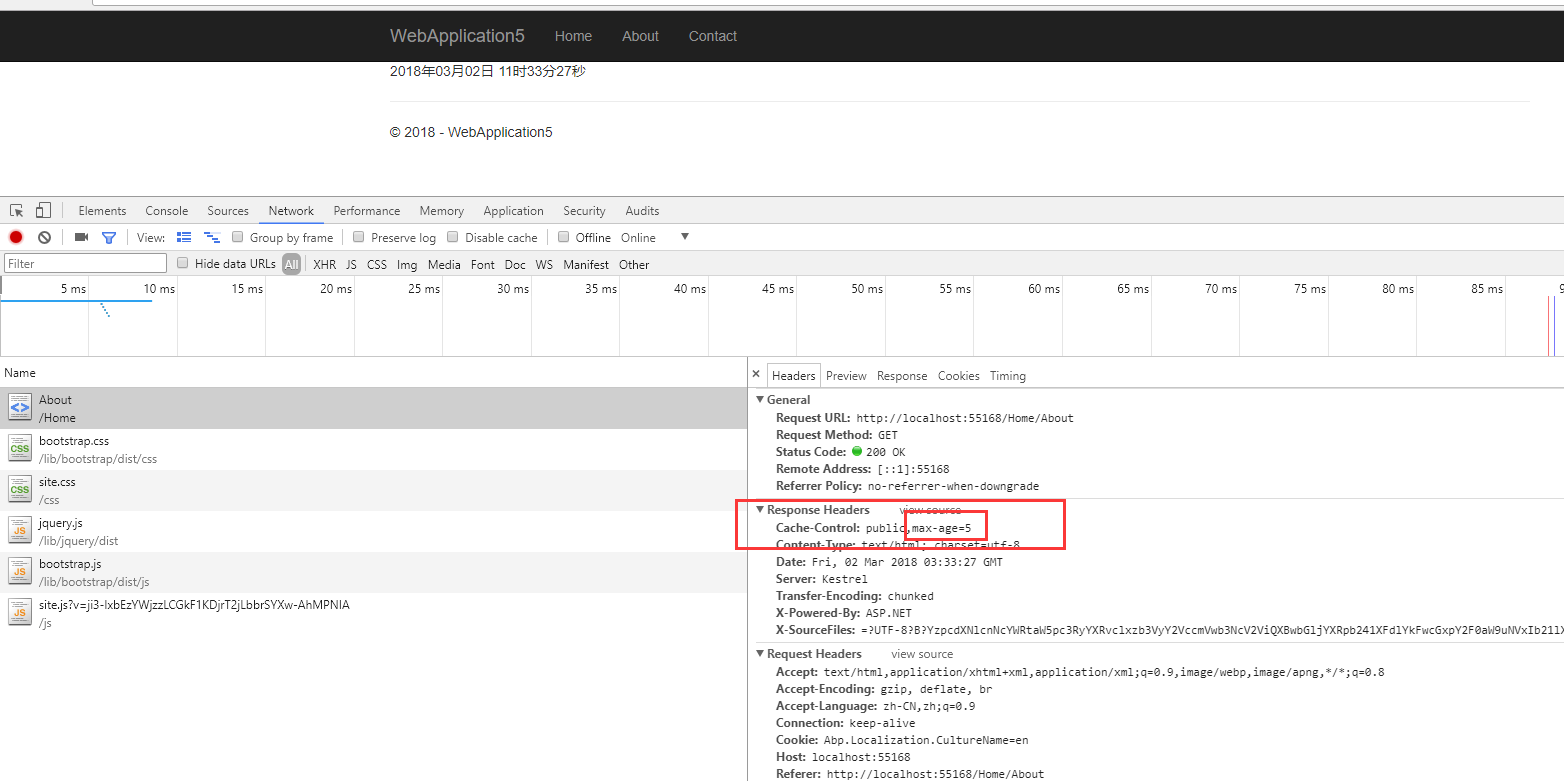响应缓存Razor 页与 ASP.NET 核心 2.0 中不支持。 此功能将支持ASP.NET 核心 2.1 版本。
在老的版本的MVC里面,有一种可以缓存视图的特性(OutputCache),可以保持同一个参数的请求,在N段时间内,直接从mvc的缓存中读取,不去走视图的逻辑。
[OutputCache(Duration =20)]//设置过期时间为20秒
public ActionResult ExampleCacheAction()
{
var time=DateTime.Now.ToString("yyyy年MM月dd日 HH时mm分ss秒");
ViewBag.time= time;
return View();
}
在Asp.Net core 2.1中,官方文档上称:响应缓存可减少客户端或代理对 web 服务器的请求数。 响应缓存还可减少量工作的 web 服务器执行程序生成响应。 响应缓存由标头,指定你希望客户端、 代理和缓存响应的中间件如何控制。
在Asp.Net Core 2.1 中,没有了OutputCache,换成了ResponseCache,ResponseCache必须带一个参数:Duration 单位为秒,最少设置一秒钟
[ResponseCache(Duration = 5)]
public IActionResult About()
{
ViewBag.time = DateTime.Now.ToString("yyyy年MM月dd日 HH时mm分ss秒");
return View();
}
然后再浏览器请求这个视图

在浏览器的响应头的Cache-Control 中出现max-age=5, Http协议对此的解释是
客户端将不会接受其保留时间大于指定的秒数的响应。 示例:max-age=60(60 秒),max-age=2592000(1 个月)
如果在浏览器中禁用缓存,那么ResponseCache不会有任何效果
Vary过滤
[ResponseCache(VaryByHeader = "User-Agent", Duration = 5)]
public IActionResult About()
{
ViewBag.time = DateTime.Now.ToString("yyyy年MM月dd日 HH时mm分ss秒");
return View();
}

关于vary在Http响应头的作用就是:告诉缓存服务器或者CDN,我还是同一个浏览器的请求,你给我缓存就行了,如果你换个浏览器去请求,那么vary的值肯定为空,那么缓存服务器就会认为你是一个新的请求,就会去读取最新的数据给浏览器
参考资料:http://www.w3.org/Protocols/rfc2616/rfc2616-sec14.html
禁用缓存(NoStore 和 Location.None)
在Http中 :no-store,请求和响应的信息都不应该被存储在对方的磁盘系统中;
[ResponseCache(Location = ResponseCacheLocation.None, NoStore = true)]
public IActionResult About()
{
ViewBag.time = DateTime.Now.ToString("yyyy年MM月dd日 HH时mm分ss秒");
return View();
}
ResponseCacheLocation.None是在Cache-Control设置一个no-cache属性,让浏览器不缓存当前这个URL
缓存配置(CacheProfiles)在一个正常的项目中,肯定有很多个控制器,但是不可能每个控制器的缓存策略都一样,这时候,我们就需要一个缓存的配置来灵活应对这个问题在mvc的服务注入的时候,我们可以在option里面注入进我们的缓存策略
services.AddMvc(option=> {
option.CacheProfiles.Add("test1", new CacheProfile()
{
Duration = 5
});
option.CacheProfiles.Add("test2", new CacheProfile()
{
Location = ResponseCacheLocation.None,
NoStore = true
});
});
然后我们在使用的时候,直接使用配置策略的名称就好了
[ResponseCache(CacheProfileName = "test1")]
public IActionResult About()
{
ViewBag.time = DateTime.Now.ToString("yyyy年MM月dd日 HH时mm分ss秒");
return View();
}
这样我们就能和之前在特性后边配置一样了,而且代码看起来也清爽了不少
总结:对于响应缓存,我个人的理解就是:MVC通过返回HTTP响应头,让浏览器在多少时间内,执行刷新操作的时候,不请求服务器,直接从缓存读取。。。